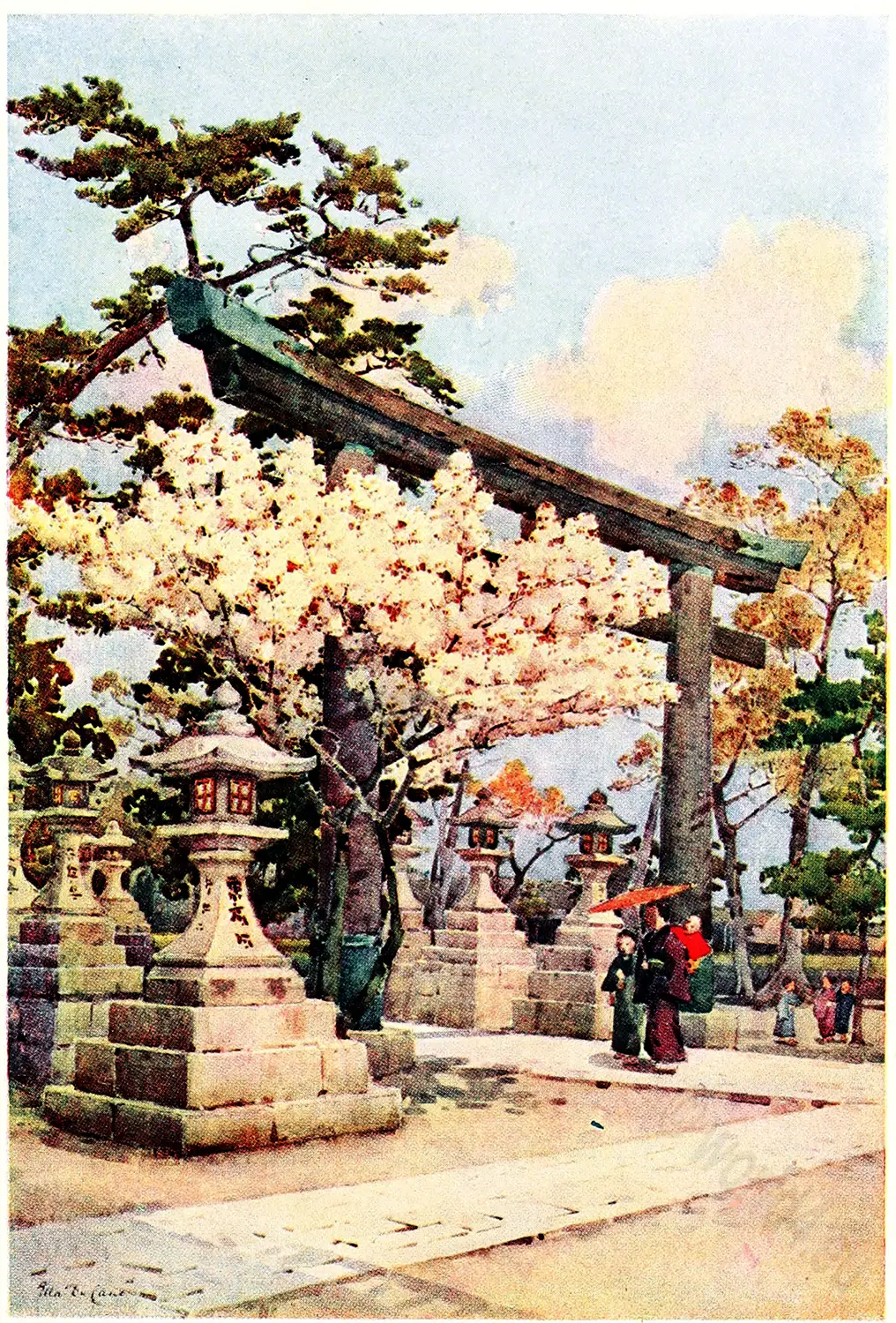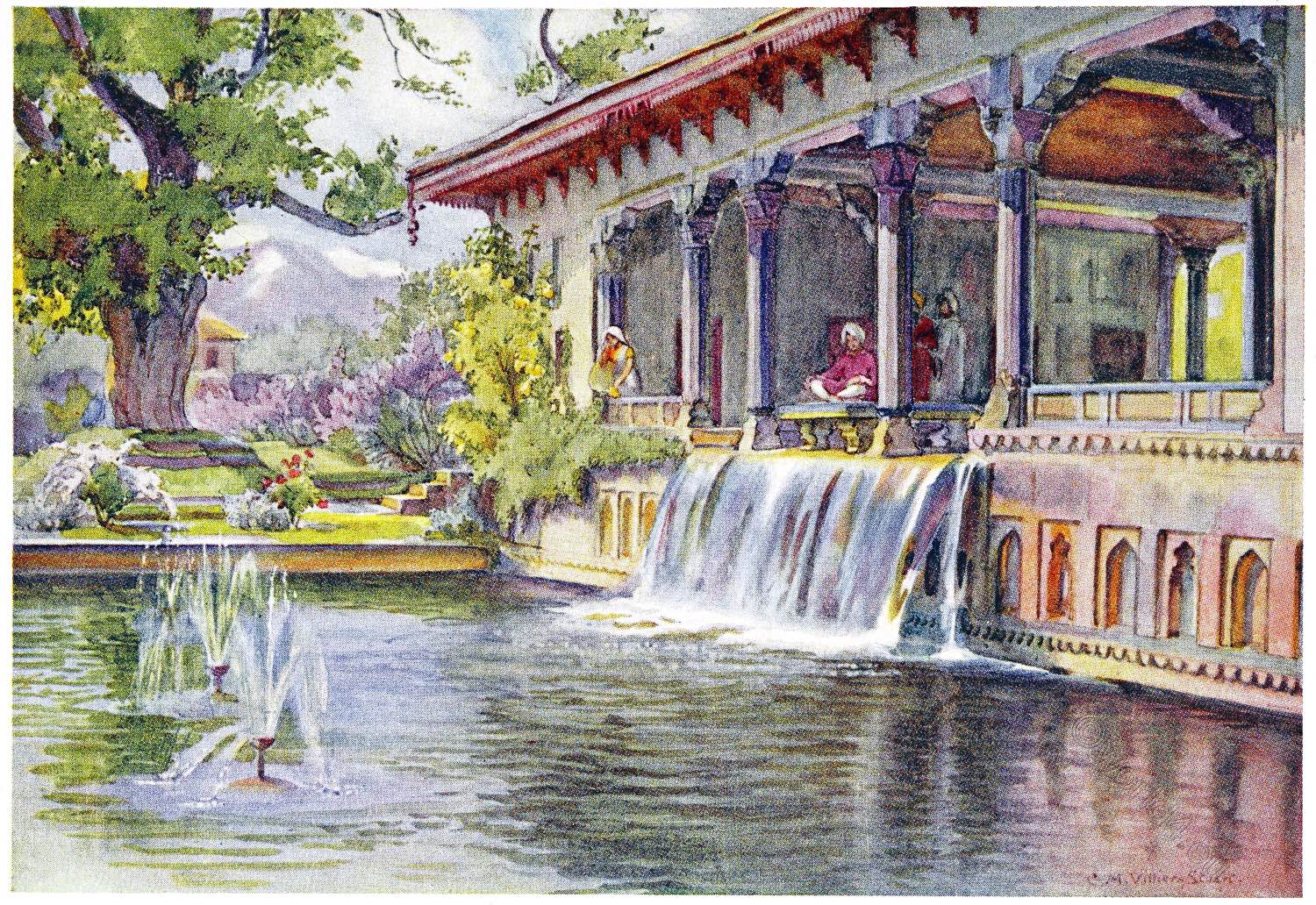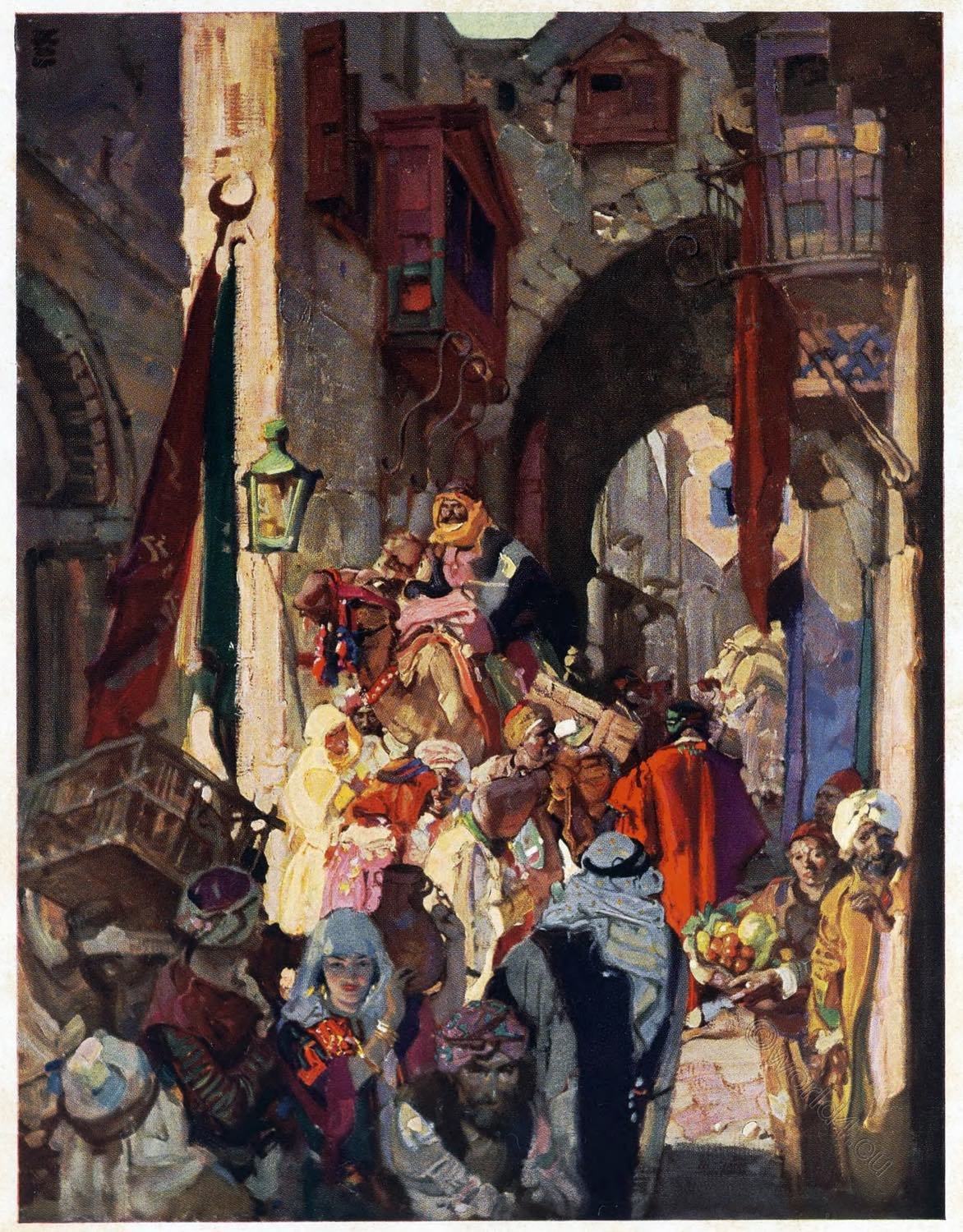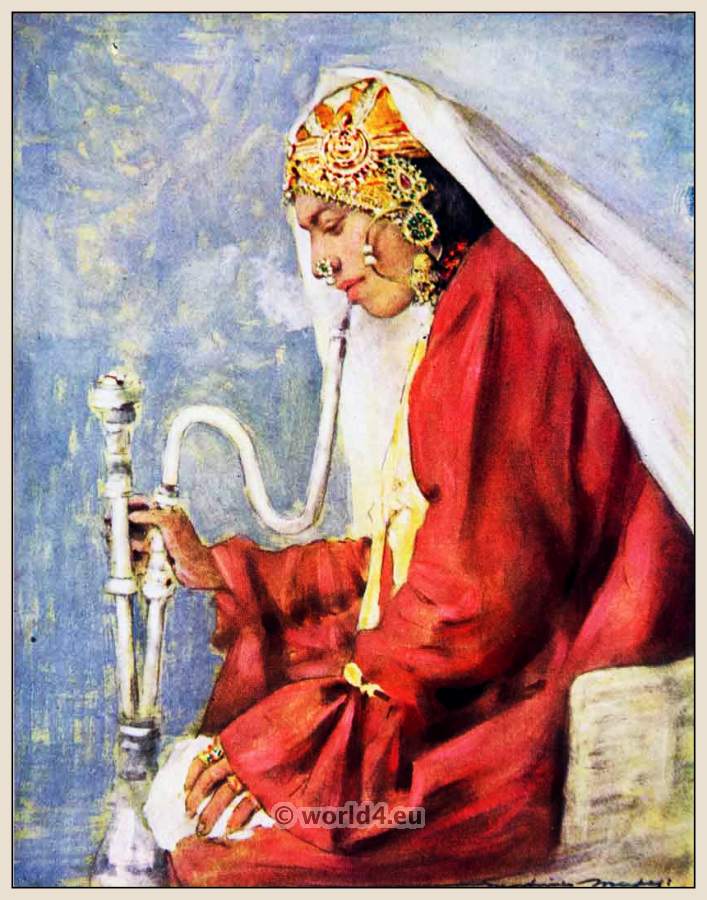Gardens of the Great Mughals. CHAPTER VIII
Summer Gardens of Kashmir
by Constance Mary Villiers-Stuart.
But see! The rising moon of Heav'n again
Looks for us, Sweetheart, through the quivering plane; How oft,
hereafter, rising will she look
Among those leaves-for one of us in vain.
OMAR KHAYYAM.
LEAVING Srinagar by the Jammu route, the old way was by boat up stream to Islamabad. A whole series of ruined gardens lies scattered throughout its length. In most cases they mark the site of royal camping – grounds, built for the convenience of the Court on the journey to and from the plains; while other gardens, like the ruins at Bawan *), which lie off the direct route, were centered round a holy spring.
*) located near Anantnag in Indian state of Jammu and Kashmir.
THE BIJBEHARA GARDEN
The garden, the remains of which now form the favorite camping-ground of Bijbehara, at the bottom of the Lidar valley, is by far the most remarkable of the riverside ruins. The plan, more resembling that of a garden in the plains than any I have seen in Kashmir, can still be clearly made out by the glorious chenar avenues (Platanus orientalis). The trees form the usual cross on a very extended scale, radiating from what was once a large tank surrounded by wide parterres, with a pavilion set in the midst of the water.
The eastern canal supplied the garden with a force of water drawn from the Lidar River, and the avenues to the north and east disclose vistas of the snow mountains which shut in this end of the Kashmir valley. The walls are broken down, but remains of octagonal towers mark their corners. There is the usual hummum *), now in ruins, and the south avenue terminates in a tank and brick pavilion.
*) A sweating bath or place for sweating
Below this building is a long river terrace-a feature, repeated on the opposite side of the Jhelum, once crossed by a stone bridge; and the originality of the whole plan lies in its carrying out Shah Jahan’s idea of a double garden, one on each side of a river.
This was formerly known as Dara Shukoh’s garden, but is now called the Wazir Bagh. The banks are steep, and the Bijbehara reach of the river is a beautiful one. The high balconied houses of the little town, and the massive forms of the chenars overhanging the stream, stand out grandly against the piled-up mountain background; and once, when the stone-edged terraces stepped delicately down on either hand, and the water from the canals fell clear over the carved cascades to join the swift broad Jhelum, Dara’s garden must have had as fine a setting as any of those built by his father Shah Jahan.
Dara Shukoh, it will be remembered, was the eldest of four brothers, and the one who inherited his father’s artistic, splendor-loving temperament; but unfortunately for himself and India, he failed in the more important quality of administrative ability. Dara, generous but conceited, proud of his intellectual gifts, and intolerant of advice or contradiction, fell an easy prey to the wiles of his brother Aurangzeb. In 1659 he was finally captured and beheaded; and the large mosque at Lahore was built with the funds derived from his confiscated estates.
*) Dara Shukoh, March 20th, 1615 – August 30th, 1659, Religious thinker, mystic, poet and author of several works in Persian. His mother was Mumtaz Mahal. The Taj Mahal was built as her tomb.
DARA SHUKOH’S ALBUM
At the age of twenty he had been married to his cousin, the Princess Nadira, to whom he remained devotedly attached, and to whom he gave the album of Mughal miniatures which still goes by his name, and forms one of the chief treasures of the India Office library. His taste can be seen in this collection of illuminations with their rhythmic line, and perfection of balanced color harmonies; the portraits of the Emperors, the decorative paintings of the favorite Mughal flowers, and pages of dreamy Persian poetry, each surrounded by floral borders as beautifully chosen as the pictures and poems they enclose.
Much Jhelum water has flowed under the old wooden bridge at Bijbehara, with the mulberry trees and elms sprouting from its piers, since Dara first built his terraced garden there on both sides of the stream. It is a far cry from his once magnificent palace at Lahore to the dark, sober-colored surroundings, the solemn hush, and the busy scratch of pens in the great official London library; but the cousins seem wonderfully near, they live again as one reads the simple preface: “This Album was presented to his Dearest and Nearest Friend, the Lady Nadira, Begam *), by Prince Mahomed Dara Shukoh, son of the Emperor Shah Jahan-1641.”
Islamabad, the second town in Kashmir, stands a few miles higher up the Jhelum from Bijbehara, just where the river narrows. It is – the starting-point for the Verinag-Jummu route.

This portrait is thought to be of Princess Nadira Banu Begum daughter of Sultan Parviz. She is seen here wearing a patka, Odhani and magnificent jewels reflecting her status.
*) Nadira Banu Begum (14 March 1619 – 6 June 1659) was a Mughal princess and consort of the imperial prince Dara Shikoh, heir to the fifth Mughal emperor Shah Jahan. Princess “Shahzadi” Nadira was born into the Timur dynasty, the daughter of Sultan Parvez Mirza (second son of Emperor Jahangir) and his wife Iffat Jahan Banu Begum. The paternal grandparents of the princess were Emperor Jahangir and his second wife Sahib-i-Jamal while her mother, Iffat Jahan Banu Begum, was also a Mughal princess as she was the daughter of Sultan Murad Mirza (second son of Emperor Akbar and his wife Salima Sultan Begum). Nadira was thus a Mughal princess of a very pure lineage, being a Timurid princess on both paternal and maternal sides. Nadira’s paternal uncle was Emperor Shah Jahan, who later also became her father-in-law. She was considered one of the most beautiful and intelligent women of her time. Her future husband learned about her and was very eager to marry her, and they had a good relationship throughout the turbulent life of the imperial prince.
At the foot of the hill, overlooking the town, there are numerous springs, and consequently remains of Mughal gardens. But only some Kashmiri pavilions, and the stone tanks which swarm with sacred carp are left.
The direct road from Islamabad to Verinag Bagh, Nur-Jahan’s favorite Kashmir garden, runs for nineteen miles across the rivers and the rice-fields-and a very bad road it is. For the traffic of the country goes down the new Jhelum valley road by Baramulla and Domel, up over the Murree hill, and out to join the railway at Rawal Pindi.
Now, if a river washes away a bridge or two between Islamabad and Verinag, no one hurries to replace it; and the old road is left to the pilgrims from the plains or to stray travelers, such as the little company who gathered in the gardens at the northern foot of the Banihal Pass to spend, after the old fashion, the last hot weeks of June by the ice-cold holy spring.
The previous autumn I had tried to reach the gardens and failed; but on my second visit to Kashmir the journey was accomplished, and I and some friends arrived there at last.

VERINAG BAGH
Camped under the chenars of the ruined garden, where the pine forest runs down a steep limestone spur to the tank in which the spring rises, it is easy to understand the romantic charm of Verinag (the secret spring, the supposed source of the Jhelum, “the snake recoiled,” as the literal translation runs) and the spell which held Jahangir and Nur-Mahal in their palace by the bright blue-green pool, where the largest of the sacred carp bore the Queen’s inscriptions on gold rings placed through their gills.
On the cold mountain pass above, Jahangir died; leaving a last request that he might be brought back and buried by the spring. But as we have seen, his wishes were set aside; -the courtiers no doubt were frightened by the approach of winter, and the danger of the passes being closed; and the Court continued their journey southwards, carrying the dead Emperor down to Lahore.
The octagonal tank built round the spring is designed to form the centre of the palace buildings. No omrah’s house at Delhi was complete without its fountain court, and the same idea is carried out on the grandest scale for the Emperor’s palace at Verinag. Round the reservoir there are twenty-four arched recesses still roofed over, some containing small stairways which led to the rooms above; and the few carved stones of the cornice that are left show how fine the building must have been. The current rushes out through the large arched crypt on the north side, flowing under the chief facade of the house. The stream, flashing through the gloom, lights up the dark arches with a flickering green magic like a mermaid’s cave, beyond which lies the serene upper world of the sunlit water-court.
The palace is built on a succession of small arches extending across the width of the first terrace. Only the lower story is left, the rest of the building having been destroyed by a fire a few years ago. A road and an ugly rubble wall shut out the terrace and turfed wooden bridges across the canals, and spoil the whole effect, which must have been most impressive when the palace walls formed the southern garden boundary, backed by the dark pines on the cliff behind the spring. The main canal is about twelve feet wide, and is crossed by a second watercourse running immediately under the building. The garden has been a large one, although it is somewhat difficult to make out the whole plan. At present the first terrace is alone enclosed, but a broken water-chute leads to a lower level, and a big hummum with stone – edged platforms and other buildings can be traced on the east side.
For those who feel the charm of solitude in a beautiful setting, Verinag Bagh is still an enchanting place to pass the early summer days. So at least we found it; reading, writing, and painting under the fruit trees, or ensconced in latticed summer-houses built across the stream, where straggling Persian rose-bushes scented the garden with their soft pink blooms. Early every morning the Brahmins in charge of the spring came to gather the flowers to decorate their shrine. Later in the day, a school of small boys were usually busy at work in the shade of a large chenar (Platanus orientalis), or were drawn up in line for a diving lesson, learning to swim with merry splashings in the clear, fast-flowing stream.
At noon even the shady garden grows too hot; and then the alcoves round the tank prove a welcome refuge, the icy water making the temperature of the surrounding court some degrees cooler than elsewhere. From the curiously vivid green depths of the tank an emerald flash lights – up a polished black marble slab let into the walls, revealing Jahangir’s inscription: “The King raised this building to the skies: the angel Gabriel suggested its date-1609.”
The mason’s tablet on the west side, erected seven years later, on the completion of the work, runs: “God be praised! What a canal and what a waterfall! Constructed by Haider, by order of the King of the World, the Paramount Lord of his Age, this canal is a type of the canal in the Paradise, this waterfall is the glory of Kashmir.”
Brave words these, but no doubts troubled Haider-a master-builder sure of his patron and his own skill. A Hindu shrine is set up in one of the arches where the marigolds and rosebuds wreath the drab plaster walls. Pink indigo bushes and lilac wild – flowers flourish on the earthen roofs, and grow between the grey cornice stones; behind which the giant poplars whisper restlessly in the lightest breeze; while over the close, delicate, northern harmonies the pine woods brood sombre and remote.
Then with a sudden burst of sound and color, a band of newly arrived pilgrims flock in to make their puja *) at the shrine. The sacred fish are fed, roses are flung into the reservoir, the pradakshina is performed. Three times round the tank they go in their saffron, mauve, and marigold robes, and the water glitters bright with all the brilliance of the hot southern plains.
*) Puja roughly means “worship” or “paying homage”. In Hinduism, the puja is a ritual that is ideally practised daily and is one of the most important components of everyday religious life. The Sanskrit term pūyā can have various meanings depending on its Buddhist, Hindu or Jain context.

THE AMARNATH PILGRIMS
Two days the summer pilgrims rest at Verinag, below the mountain pass. Then they toil on to Achibal, over the stony Sandrin river-bed, and up the rugged hill behind Shahabad, which is covered in the early summer with creamy peonies and the lovely Kashmir rose; the wild rose resembling masses of bright pink gorse-so close the flowers, so prickly their stems.
The temple of Martand *), on the plateau above Islamabad, is the third place of pilgrimage; the splendid ruin through whose colonnade the ninety miles of valley can be seen. To the north, at the foot of the Martand plateau, is Bawan; and far up, near the glaciers at the head of the Lidar River, lies Amarnath Cave, with its frozen spring representing Siva the Preserver.
*) Dedicated to the Hindu sun god Surya (other Sanskrit name: Martand), the temple was built by King Lalitaditya-Muktapida (r. c. 723-760) of the Karkota dynasty in the first half of the 8th century – possibly on the site of a 4th or 5th century predecessor. At the beginning of the 15th century, the troops of the Muslim conqueror Sikandar Butshikan (r. 1389-1413) destroyed the temple complex. It was not until the 19th century that the British, who ruled India at the time, discovered the building and its significance; they subsequently undertook extensive safeguarding and restoration measures. The ruins of the Martand Sun Temple are of great historical and cultural significance for the Kashmir Valley. In addition, the early Hindu temples of Kashmir are of great political significance in the ongoing conflict between India and Pakistan over the region’s allegiance.
This is the goal of the pilgrimage, the whole object of all these weary months of marching. Here the poorer pilgrims turn homewards; and they are nearly all poor; these travelers by the old Jammu way. So they rarely journey farther down the main Kashmir valley, or see Srinagar, with its water-streets, its curiously carved shops and houses, its Imperial lake-side gardens, and its new well -laid roads. – The same remark applies to quite another class of pilgrim, who, entering the valley at the opposite end, race up to Gulmarg *); and all that many of these pilgrims see of Kashmir is the forest, the faint glistening mountains of the Indus, and the smooth, green bowl-shaped meadow at their feet, where round and round the links they go, pursuing the British god of games.
*) Gulmarg is a wide valley and namesake of the village located in it in the Baramulla district of Jammu and Kashmir in India. The name Gulmarg means “flower meadow”.
Bernier *) went to Achibal (Achibal Bagh – Achabal Garden) along the pilgrims’ way. “Returning from Send-bray (Bawan) I turned a little from the high road for the sake of visiting Achiavel (Achibal), formerly a country house of the Kings of Kashmir and now of the Great Mogol. What principally constitutes the beauty of this place is a fountain, whose waters disperse themselves into a hundred canals round the house, which is by no means unseemly, and throughout the gardens.
*) Travels in the Mogul Empire, A.D. 1656-1668, by Bernier, François, (1620-1688). Published by Westminster, Eng: Constable, 1891.
AN IDEAL SITE
The spring gushes out of the earth with violence, as if it issued from the bottom of some well, and the water is so abundant that it ought rather to be called a river than a fountain. It is excellent water, and as cold as ice. The garden is very handsome, laid out in regular walks, and full of fruit trees; apple, pear, plum, apricot, and cherry. Jets d’ eau (Fountain) in various forms and fish ponds are in great, number, and there is a lofty cascade which in its fall takes the form and color of a large sheet, thirty or forty paces in length, producing the finest effect imaginable; especially at night; when innumerable lamps, fixed in parts of the wall adapted for that purpose, are lighted under this sheet of water.”
As in the case of nearly all these Kashmir gardens, the lowest terrace is destroyed by the highway, and Achibal Bagh is much smaller than it was in Mughal days. But nothing can spoil the natural loveliness of this river, gushing out of the honeycombed limestone cliff, just at the point where the mountains intrude farthest on the plains. It is an ideal site.
If I were asked where the most perfect modern garden on a medium scale could be devised, I should answer without hesitation, Achibal. Nowhere else have I seen such possibilities for the combined appeal of a stately stone – bordered pleasance between ordered avenues of full- grown trees, and a natural rock and woodland upper garden with haunting, far-reaching views, where the white – wild roses foam over the firs and the boulders, rivaling the “sheet of water” Bernier praised.
The garden, which had fallen into decay, was re-enclosed on a smaller scale by Gulab Singh, the grandfather of the present Maharaja of Kashmir. Opening out of the south wall there is a large harem building, with a Mughal hummum and a swimming tank for the ladies in the centre of the square.
The actual pavilion through which the spring bursts out is broken down, and all that remains is an arched recess, a ruined portal set against the side of the cliff. One would give much to see in what manner the great rush of water was first confined and utilized. On either side of the reservoir into which it falls is a stone-edged chabutra *) shaded by big chenars (Platanus orientalis).
*) Chabutro or Chabutaro or Chabutra is a tower-like building with octagonal or pentagonal rooms at the top, usually used as a dovecote.
There are several Kashmiri pavilions built on the Mughal stone foundations; delightful little structures with their cream plaster walls and rich brown cedar woodwork, their airy latticed windows and their carved flower-bell corbels.
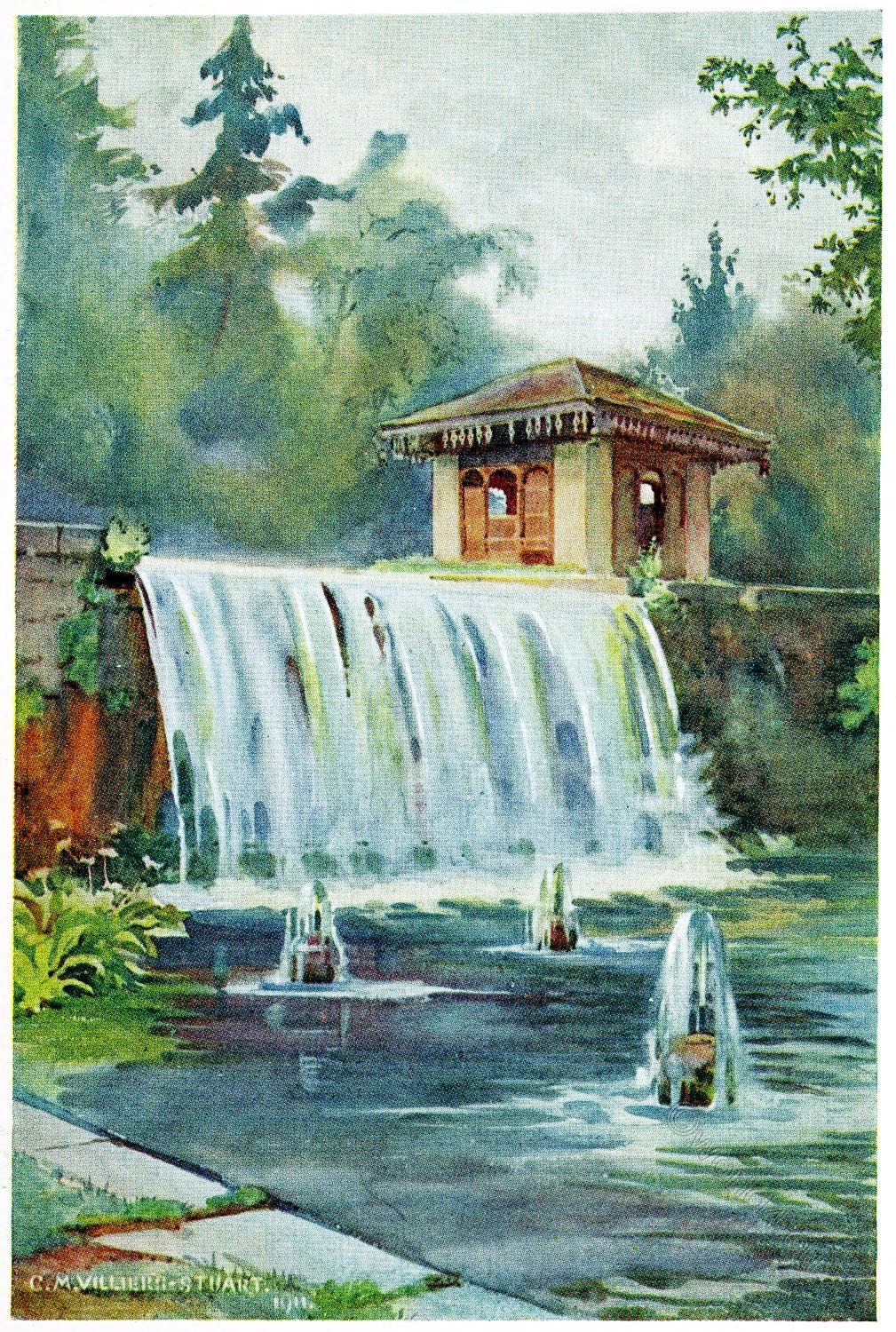
ACHIBAL BAGH
They are neither as elaborate nor so fine as the older work of the same class scattered up and down the country; but they are beautiful and useful none the less, and represent a national living art, which the builders of the Srinagar villas and’ the pine huts of Gulmarg might with advantage make more use of than they do. In many out- of-the-way villages the old tradition lives, and the head man’s new house springs up adorned with rough but tasteful plaster-work and the cunning carving of an older day.
One reads therefore, with something more than astonishment, the Report written only five years ago, which, in its archeological zeal for Mughal work, recommended that the Kashmiri pavilions should be pulled down to the level of the underlying stone, not on account of their ugliness or want of utility, but merely because they were not Mughal! Surely this is a short-sighted and unhistorical view.
The antiquarian spirit in India is a pious one; but without a sense of proportion, a study of the life of the people, and esthetic enthusiasms, it will have no force or driving power. Meanwhile the clever carvers of Srinagar spend their time on hideous, over – elaborated travesties of European furniture, tortured tea-tables, and uncomfortable chairs, not that they have forgotten the larger and bolder work so suited to their style, with its balconies and the flower – bell ends, but for the simple reason that nobody nowadays wants such things.
The Delhi Durbar showed what Kashmir workmen well inspired could do. The gateway of their Maharaja’s camp was perhaps not very happy-a stone temple design carried out in wood-but the high pierced and carved railing on either side of it was one of the most beautiful and satisfactory examples of modern Indian craftsmanship.
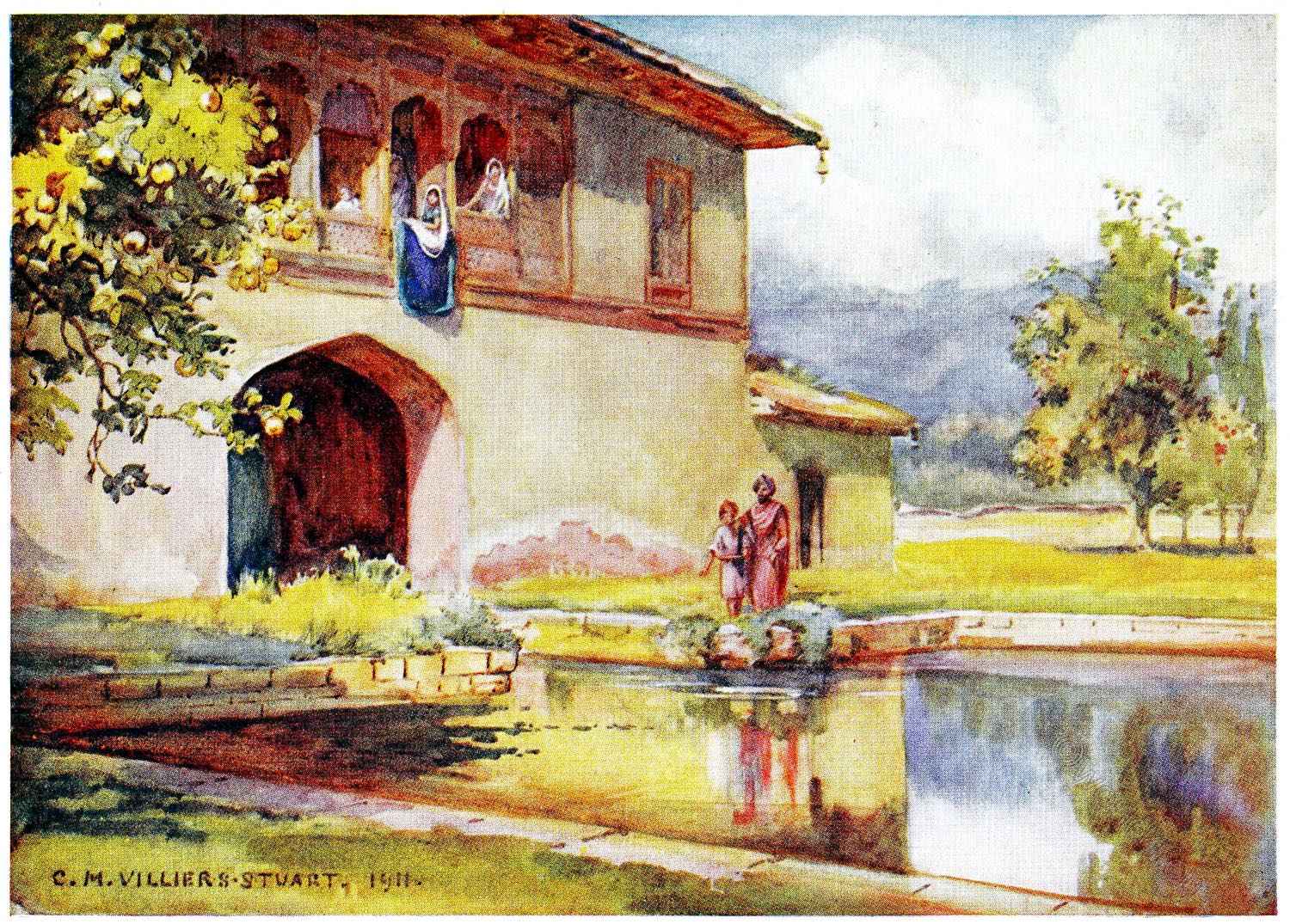
GARDEN PAVILIONS
An Indian garden where each baradari in its turn is as purposeful as it is decorative, should not only be looked at, but should be lived in to realize its charms. At Achibal the summerhouse set in the tank just beneath the waterfall is planned for the noontide rest, lulled by the sound of the cascade, cooled by the driving spray. As the shadows lengthen, carpets are spread on the chabutras under the huge chenars, and towards sunset the upper pavilions near the spring are used.
Seen from the forest walks above the light on the submerged rice-fields turns the valley into a golden sea, on whose southern shores rise the peaks of the Pir Panjal *), like giant castles, with the long, monsoon cloud pennants streaming from their towers. At night, from the gallery of the large pavilion the garden shows a vague, mysterious form; marked out by the shapes of the dark chenars, the grey glimmer where the cascade foams, and the reflections of the stars in the pools.
*) The Pir Panjal is a mountain range in the Near Himalayas. It runs over a length of 440 km from east-southeast to west-northwest through the Indian state of Himachal Pradesh, the Indian-administered territory of Jammu and Kashmir and the Pakistan-administered Asad Kashmir. The average altitude ranges from 1400 m to 4100 m. The Pir Panjal is the largest range of the Anterior Himalayas.
Old histories and stories haunt the garden: – of Jahangir and his Nur-Mahal, and Majnum and Laila *) claim this Paradise again – he in his hopeful cypress shape, she on her rose-bush mound. For Moslem garden-craft, like Mughal painting, is full of symbolism, and rich with all the sensuous charm and dreaminess of the old Persian tales; and the story of Laila and Majnum,· the faithful lovers who only saw each other twice on earth, is most frequently memorialized in the garden.
Two low-growing fruit trees, such as a lemon and citron, or a lemon and orange tree, planted in the midst of a parterre of flowers, are the lovers happy in Paradise; the same idea, is also illustrated by two cypresses, or the so called male and female date palms, which are generally planted in pairs. The design of the double flower-beds in which the two symbolic trees were planted can be seen in the brick parterre at Lahore and in those of the Taj. Majnum’s sad, earthly symbol is the weeping willow (baide majnum), whose Laila, the water lily, grows just beyond his reach. Two cypress trees are frequently grown as their emblems, and the prettiest and quaintest emblem of all is Laila on her camel litter, a rose-bush on a little mound.
Dark purple violets mean the gloss and perfume of her blue-black hair, saman (jasmine, which also means a foaming stream) is Laila’s round white throat, “cypress-slender” is her waist, tulips and roses are her lips and cheeks, and the fringed, starred narcissus her eyes. There are other garden legends more difficult to discover, and traditional ways of memorializing well-known verses by the planting and arrangement of the trees. But the old craft is dying for want of encouragement, and we must be quick if we would secure its secrets.
*) Layla (also Laila, Lalli) and Majnun” is the third poem of the classic of Nizami Ganjavi (1141–1209), written in 1188 in Persian. The poem of Nizami on the loves of Layla and Majnum (or of Crishna and Radha), though built upon a circumstance of true history, is avowedly mysterious, and allegorically describes the raptures of divine affections. The Persian poet Hafiz, throughout the whole of his odes, seems to use the name of Laili, when speaking of the Supreme Being; and Maulavi declares, that the impassioned descriptions of love, which breathe through their writings, do not relate to the gross and sensual affections, but that they mystically paint the workings of the spiritual desire of the foul towards the great Author of her existence. The poem on the loves of Laili and Majnum is not the only instance of a composition having both a primary and secondary signification; the East abounds with songs of this nature.
MOSLEM GARDEN SYMBOLISM
Green, white, and brown are June colors at Achibal, for the garden itself has few flowers, though some of the old orchard trees have been spared; and in autumn the quince trees weave a spell of their own when the gnarled boughs droop over the water with their burden of pale yellow balls.
To plant fruit trees close up to the edges of the reservoirs was a favorite custom. And a very pretty one it was. Nothing was more tiresome in the English garden of the last century than the sham gentility which spoke of “ornamental trees” as if they must be necessarily useless ones, and banished the apple, plum, and pear trees to the distant kitchen garden regions. Well, that is past now, and thanks chiefly to Japan, the orchard is again in favor.
But we might have been reminded of its beauties long ere this, for every Indian garden was once full of fruit trees; Moslem and Hindu artists never tire of their symbolic contrast with the cypress; and Babar noted long ago: “One apple tree had been in excellent bearing. On some branches five or six scattered leaves still remained, and exhibited a beauty which the painter, with all his skill, might attempt in vain to portray.”
Source:
- Gardens of the Great Mughals by Constance Mary Villiers-Stuart. London: A. and C. Black, 1913.
- Journals kept in Hyderabad, Kashmir, Sikkim, and Nepal. Edited, with introductions, by R. C. Temple. With maps and illustrations. London, W. H. Allen & Co. 1887.
Related
Discover more from World4 Costume Culture History
Subscribe to get the latest posts sent to your email.

